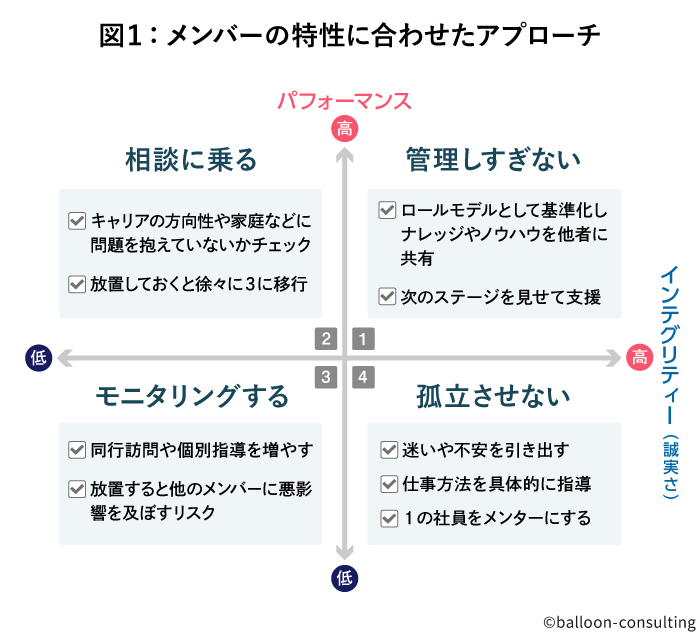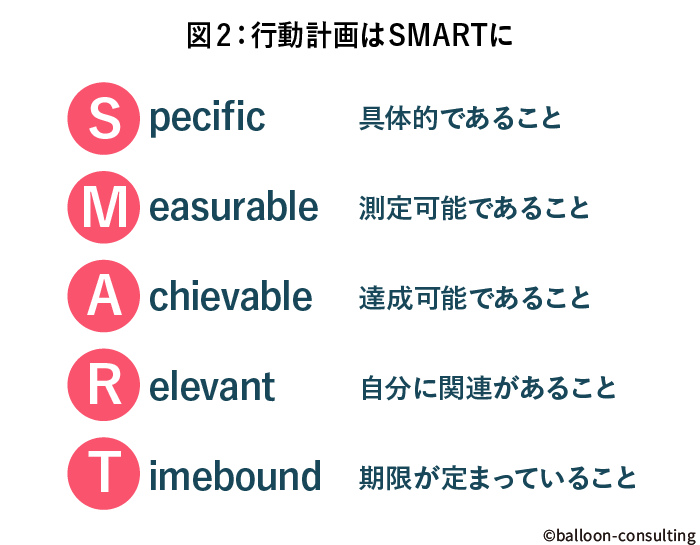The pandemic has inadvertently normalized remote work in Japanese society, presenting new challenges to how we work. In Part 1, we introduced key points for fostering creative collaboration during online meetings.
In this second part, we introduce key points for team management to achieve smooth communication even when physically separated from subordinates and team members.
Remote work often breeds anxiety: team leaders worry they can't control members in physically distant locations, while members fear their work isn't visible. Less experienced members also struggle with frequently consulting seniors or supervisors about minor issues. The skill needed now is bridging physical distance gaps while enhancing teamwork quality.
Gain an Overview of Team Member Characteristics Using Four Quadrants
In a remote environment, the first skill required of team leaders is a bird's-eye view of the entire team. While in an office, it's easy to see who is doing what and what challenges they face, but when separated, this becomes difficult to discern, and the perspective needed to maximize performance through team collaboration is often lacking. Furthermore, it's important to note that differences in the quantity and quality of communication with each member can easily arise.

Figure 1: Tailoring Approaches to Member Characteristics
Figure 1 above classifies members into four types and provides a framework for considering approaches tailored to each characteristic.
The vertical axis is the "Performance Axis," classifying members based on whether they are achieving sufficient results in their current tasks. The horizontal axis is the "Integrity Axis." While "integrity" is a concept difficult to translate precisely into Japanese, for the purposes of this article, please consider it to mean "sincerity in how work is conducted and in communication with others." By classifying team members' characteristics using these four axes and adopting communication approaches tailored to each, we can maximize the overall performance of the entire team.
1.Members classified as "High Performance & High Integrity" should not be overmanaged.
These members are essentially "model employees" who deliver strong results and communicate sincerely with supervisors and peers. Rather than micromanaging them, it's better to leverage them as team role models. They can share their knowledge and expertise with others or mentor less experienced members. Additionally, to further enhance their loyalty, it's important to understand their aspirations and show them the "next stage" to encourage continued growth.
2.Members with "High Performance & Low Integrity" require consultation.
These members deliver results but may fall short in reporting, communicating, and consulting with their superiors, or lack awareness of consideration for others and knowledge sharing. They often seem to think, "As long as I get the job done, that's good enough." Such individuals may actually harbor dissatisfaction or anxiety about their work. They also carry the risk of shifting into Quadrant 3 (see below) if they encounter situations preventing them from delivering results. Leaders must communicate thoroughly, drawing out any dissatisfaction with current tasks or anxieties about future career paths while providing appropriate guidance.
3.Monitor members classified as "Low Performance & Low Integrity."
This category includes members who are not achieving sufficient results and also have communication issues with others, often labeled as problem children by their peers. If left unattended, this type of employee not only experiences increased personal stress but also poses a high risk of negatively impacting surrounding members. For such members, leaders must consciously increase monitoring frequency—such as actively increasing individual coaching or always accompanying them to external meetings—and invest effort in promoting growth through detailed guidance.
4.Members with "Low Performance & High Integrity": Avoid Isolation.
These are members who, while not currently delivering results, demonstrate a sincere attitude toward their work and maintain honest daily communication with their colleagues. This type of talent has a high potential to gradually achieve results when provided with the appropriate environment and guidance. Leaders must ensure these members are not underestimated or isolated by others based on their current performance. What this type of talent needs is specific guidance for improving their lacking skills. To achieve this, assigning them a mentor from the first type mentioned above and providing learning opportunities is also effective.
Action Plans Should Be SMART
Figure 2 summarizes key points for individual communication with each member.

Figure 2: Action Plans Should Be SMART
In remote environments, clear role allocation and detailed communication among team members are even more essential than in face-to-face settings.
To align team outcomes with individual achievements and motivation, discussions should be grounded in specific, concrete events rather than abstract concerns or emotional arguments. Furthermore, when setting goals, it is essential to agree on measurable metrics.
Furthermore, engagement increases when members share a challenging yet achievable vision or goal, based on their current capabilities, and when these align with their individual qualities and career aspirations.
Finally, remember to carefully communicate and agree on specific timeframes for "what to achieve by when," distinguishing between medium-to-long-term goals and short-term goals.
Ways to Enhance Team Strength Outside of Meetings
Opportunities to enhance team strength aren't limited to work-related meetings or individual interviews. As needed, consider the following approaches to foster mutual understanding among members and improve teamwork:
1.Establishing an "Open Chat Room"
Set a specific day and time for regular, casual chats where any team member can freely participate. Topics don't necessarily have to be work-related. In remote environments, many team members experience varying degrees of anxiety about what others are doing or whether they're being left behind. Exchanging updates in a casual atmosphere is effective for building psychological safety within the team.
2.Establishing "Office Hours"
Similar to the open chat room, this is held regularly, but it is specifically dedicated to "junior or less experienced members consulting with supervisors or senior colleagues." In a remote environment, it can be difficult to ask nearby seniors for help with minor work-related questions, and those providing guidance may also find it hard to grasp what their subordinates or juniors are struggling with. Setting aside regular consultation time not only promotes growth but also provides a good opportunity to check on their mental well-being.
3.Leaders themselves must actively communicate the organization's vision and their own perspectives
Maintaining and strengthening organizational solidarity and members' sense of belonging in a remote environment is a major challenge. To address this, those in leadership roles must consciously communicate the organization's overall direction and the role of their department or team within it—even more so than in an in-person setting—using their own words. This goes beyond merely driving the efficient execution of immediate tasks. Traditionally, such opportunities were primarily provided through offline company events like New Year's addresses or all-hands meetings. However, going forward, leaders' ability to communicate effectively in online environments will become crucial for strengthening organizational culture. As someone specializing in internal communications, I'm seeing an increase in consultations from companies seeking to enhance employee solidarity and promote proactive action toward realizing their corporate vision, especially now during the significant impact of the pandemic.
Remote work was originally promoted to create environments where diverse talent could work authentically. However, this simultaneously means that for organizational leaders, starting with top management, updating their presentation and storytelling skills and mindset to suit the remote environment is now an urgent priority for strengthening organizational culture.





